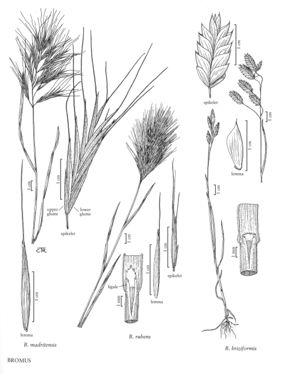Bromus madritensis
Plants annual. Culms 34-70 cm, erect or ascending, glabrous or puberulent below the panicle. Sheaths densely short-pubescent or glabrous; auricles absent; ligules 1.5-2 mm, glabrous, obtuse, erose; blades 4-20 cm long, 1-5 mm wide, flat, both surfaces pubescent or glabrous. Panicles 3-15 cm long, 2-6 cm wide, open, erect; branches (at least some) 1-3+ cm, ascending to spreading, never drooping, usually visible, with 1 or 2 spikelets. Spikelets 30-50 mm, longer than the panicle branches, not densely crowded, with parallel sides or widening distally, moderately laterally compressed, with 6-10 florets. Glumes pilose, margins hyaline; lower glumes 5-10 mm, 1-veined; upper glumes 10-15 mm, 3-veined; lemmas 12-20 mm, linear-lanceolate, often arcuate, pubescent, with longer hairs near the margins, 5-7-veined, rounded over the midvein, margins hyaline, apices acuminate, teeth 1.5-3 mm; awns 12-23 mm, straight or arcuate, arising 1.5 mm or more below the lemma apices; anthers 0.5-1 mm. 2n = 28.
Distribution
Md., Ill., Mich., Va., Calif., Pacific Islands (Hawaii), Miss., Ariz., Oreg., Nev.
Discussion
Bromus madritensis is native to southern and western Europe. It is now established in North America, and grows in disturbed soil, waste places, banks, and road verges in southern Oregon, California, and Arizona.
Selected References
None.
